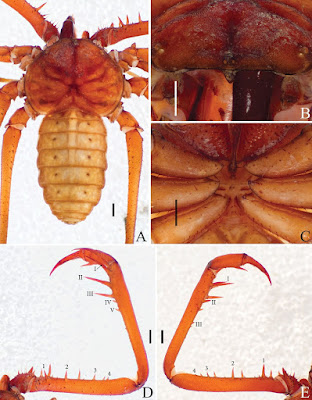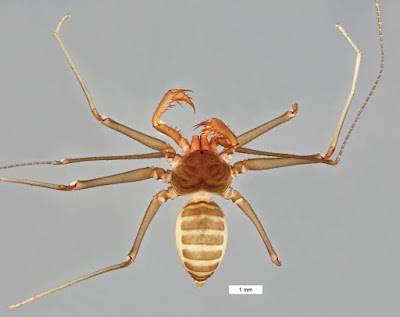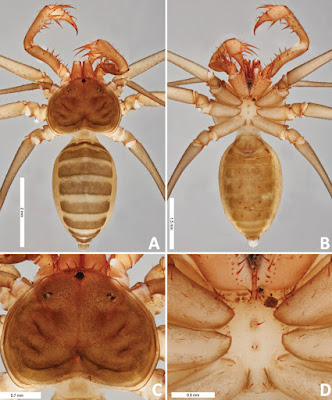 |
| Sarax timorensis Miranda & Reboleira, 2019 |
Abstract
The whip spider genus Sarax Simon, 1892 is widely distributed throughout Southeast Asia and part of the Indo-Malayan region. The genus is recorded from several Indonesian islands, but no species are known from inside the area that comprises the biogeographical region of Wallacea, despite being recorded from both sides of the area. An expedition to survey the biology of caves in Timor-Leste (formerly East-Timor) discovered populations of amblypygids living underground and including a remarkable new species of Sarax, S. timorensis sp. n., the first Amblypygi known from the island of Timor. The new species is here described bears the unique character state of two pairs of lateral eyes, instead of three or none as in all other living species of Amblypygi, and expands the biogeographic range of the genus. New records of amblypygids are given for two caves in Timor-Leste. A detailed description and a discussion of its distribution and the species characters are also provided.
Keywords: cave, tailless whip scorpions, troglobiont, Wallacea
 |
| Figure 1. Details of Sarax timorensis sp. n. A Dorsal habitus B Frontal process and eyes C Sternum D Dorsal view of pedipalp E Ventral view of pedipalp. Scale bar: 1 mm. |
Taxonomy
Charinidae Quintero, 1986
Sarax Simon, 1892
Sarax timorensis sp. n.
Type material: Holotype: Timor-Leste: Lautém district, Puropoko Cave, 8.543832N 127.066215E, 6–12.ix.2016, A.S.P.S. Reboleira leg. (male, NHMD). Female unknown.
Diagnosis: Sarax timorensis sp. n. can be recognized by the large size (body total length 12.82 mm), presence of only two pairs of lateral eyes, eight frontal setae, cheliceral claw with six teeth, two spines on dorsal pedipalp tarsus, male gonopod with sclerotization on the base of fistula, dorsal lobe and lateral lobe II, basitibia IV with four pseudoarticles and distitibia IV with six trichobothria on the frontal and caudal series. The new species can be distinguished from its congeners by the presence of only two pairs of lateral eyes, a unique character state known only from a few fossil species (Kronocharon longicalcaris Wunderlich, 2015 and Paracharonopsis cambayensis Engel & Grimaldi, 2014). Sarax timorensis sp. n. differs from the fossil species by the size (new species much larger) and the number of spines on the pedipalp. Female unknown.
Habitat: The new species was found in a cave on the border of the Ira Lalaro Lake, a huge closed karst depression in the Eastern part of the Timor Island (Freire et al. 2017; O’Connor et al. 2017). The atmospheric temperature in the cave is 32 °C. The cave has a stream with a high density of leeches in its substrate and harbors a large colony of Chiroptera. Some snakes were also observed hunting the bats in its narrow galleries. The high content in bat guano gives rise to high densities of cockroaches which are very active along the cave.
Gustavo Silva de Miranda and Ana Sofia P. S. Reboleira. 2019. Amblypygids of Timor-Leste: First Records of the Order from the Country with the Description of A Remarkable New Species of Sarax (Arachnida, Amblypygi, Charinidae). ZooKeys. 820: 1-12. DOI: 10.3897/zookeys.820.30139
---------------------------------------------------------------
روابط التحميل والمشاهدة، الروابط المباشرة للتحميل
او
شاهد هذا الفيديو القصير لطريقة التحميل البسيطة
كيف تحصل على مدونة جاهزة بآلاف المواضيع والمشاركات من هنا
شاهد قناة منتدى مدونات بلوجر جاهزة بألاف المواضيع والمشاركات على اليوتيوب لمزيد من الشرح من هنا
رابط مدونة منتدى مدونات بلوجر جاهزة بآلاف المواضيع والمشاركات في أي وقت حــــتى لو تم حذفها من هنا
شاهد صفحة منتدى مدونات بلوجر جاهزة بألاف المواضيع والمشاركات على الفيس بوك لمزيد من الشرح من هنا
شاهد صفحة منتدى مدونات بلوجر جاهزة بألاف المواضيع والمشاركات على الفيس بوك لمزيد من الشرح من هنا
تعرف على ترتيب مواضيع منتدى مدونات بلوجر جاهزة بآلاف المواضيع والمشاركات (حتى لا تختلط عليك الامور) من هنا
ملاحظة هامة: كل عمليات تنزيل، رفع، وتعديل المواضيع الجاهزة تتم بطريقة آلية، ونعتذر عن اي موضوع مخالف او مخل بالحياء مرفوع بالمدونات الجاهزة بآلاف المواضيع والمشاركات، ولكم ان تقوموا بحذف هذه المواضيع والمشاركات والطريقة بسيطة وسهلة. ــــــــــــــــــــــــــــــــــــــــــــــــــــــــــــــــــــــــــــــسلامـ.
















